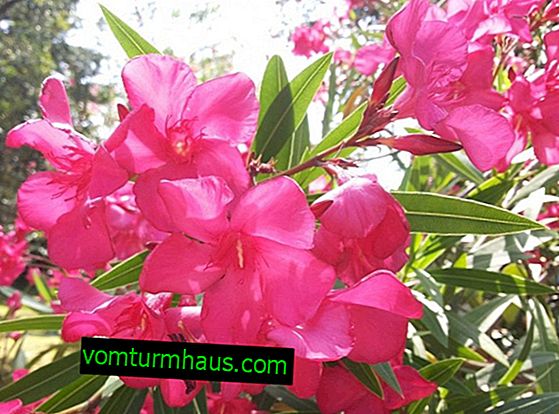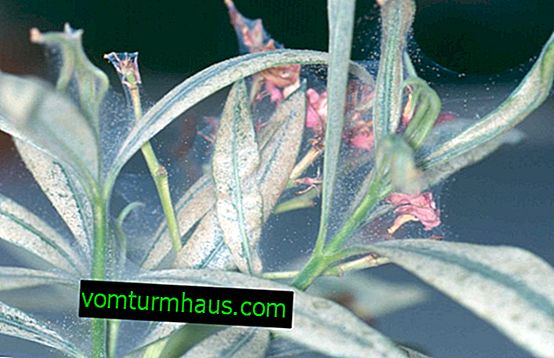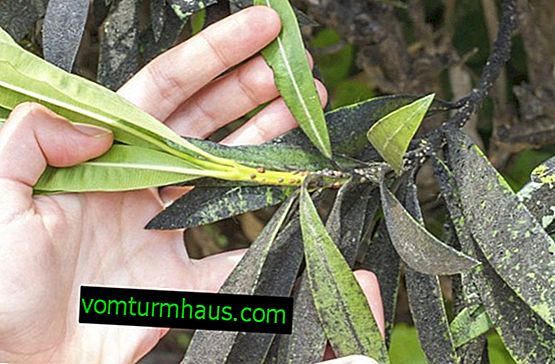Oleander: care and growing at home
Oleander is a beautiful evergreen ornamental shrub that often decorates landscapes or contains houses as a houseplant. Subtropics of the Northern Hemisphere are considered his homeland, and he himself has some features of cultivation. They will be discussed in this article.
Botanical description of the plant
In the natural habitat, an oleander is a bush or a small tree that can grow up to three to four meters in height. At home, with regular pruning, you can ensure that it does not grow above a meter. Its stem is branched, brownish in color and covered with rounded lentils. Foliage lanceolate or linear-lanceolate with a length of about 0.1-0.15 m and a width of about 0.03 m. To the touch, smooth, leathery. It grows on short petioles. Each leaf has a bright vein in the center, the main tone is dark green.
Important! Poisonous substances are mainly concentrated in the juice of the bush. It also has a number of glycosides that are used for medical purposes.
The bush blooms with bright large five-membered flowers from pale pink to bright pink. The corolla in them is most often white or pink. Oleander blooms from early summer to mid-autumn, depending on the climate of the region. When the flowers fade, in their place appear up to 20 cm long leaflets-fruits, which, ripening, begin to crack and release a lot of seeds with a crest. Oleander refers to poisonous plants, so when cultivating it, you need to be extremely careful.
















| Root system | powerful, branchy |
| Stem | branching, brown, with rounded lentils |
| Leaf shape | lanceolate or linear lanceolate |
| Leaf color | dark green |
| Flower shape | five-membered, in corymbose inflorescences |
| Flower color | pale to bright pink |
| Fruit shape | leaflet |
| Fruit color | brownish brown, maybe with a green tint |
The main types
The genus oleander has only one species - the oleander ordinary.
This only representative of the genus is represented by such varieties:
- Variegata - blooms with yellow terry flowers, the foliage is dark green with an uneven cream border;

- Hardy red - has green-gray foliage, during flowering is covered with bright scarlet flowers;

- Cardinal - blooms in burgundy color;

- Soleil Levant - densely covered with delicate pink or salmon flowers with an orange core.

House growing conditions
Oleander is an intensively growing large shrub that requires close attention and certain conditions of detention.
Lighting
A tropical plant needs intense and long-lasting lighting. With its deficiency, it begins to actively discard the leaf and flowers, so it needs to be placed on the south side, and in summer even taken out to the balcony or to the garden. In the absence of the ability to provide the bush with access to natural light, it is necessary to use artificial lighting. You can not do without it in the cold season, since the plant needs an eight-hour daylight.
Did you know? Oleander is a symbol of the city of Hiroshima.
Ventilation
Oleander flowers are very fragrant, but there are stupefying notes in them, which is why they can harm a person, causing dizziness. In order to adjoin a flower normally, it must in no case be placed in living rooms, and it is also necessary to regularly ventilate all rooms. In addition, airing is also useful for the normal growth of the bush, since moisture accumulated in excess in the air negatively affects its condition.

Temperature mode
From spring to autumn, the flower has a period of intense growth. For this period of time he needs to provide a high temperature - +20 ... + 28 ° С. From autumn to winter, inclusive, the vegetation process slows down. The temperature should be gradually lowered to +15 ... + 18 ° C.
Important! In winter, you can not allow the temperature to fall below +8 ... + 10 ° С. This negatively affects the further growth of the plant.
Air humidity
Where oleander grows, the amount of moisture in the air should be slightly above average. To maintain humidity at the proper level will help the location near the pot with a flower of water tanks or a humidifier. You can simply periodically spray the foliage from the spray bottle.
Oleander care at home
Oleander is an unpretentious shrub, but since it comes from hot humid regions, you need to know how to properly care for it at home.
Watering
Care must be taken to monitor soil moisture during flowering. It should be wet to a depth of 1-1.5 centimeters. As soon as the topsoil dries, the oleander needs to be watered. For irrigation should use soft, standing warm water. After each watering, it is necessary to drain the remaining water from the pan so that there is no rotting of the roots. During dormancy, irrigation is needed less intense. Irrigate the flower should be two to three days after the topsoil is completely dry.

Top dressing
Fertilizers are applied during the growing season. The frequency of feeding is 10-14 days. Used liquid purchased mineral fertilizers or prepared independently from a mixture of 1.5 g of superphosphate, potassium and 2 g of nitrate, diluted with water in the volume of one liter.
Important! Instead of nitrate, you can use urea.
Pruning
An intensively growing shrub needs constant crown formation. This procedure will allow you to slightly pacify the growth of the oleander, give the bush a regular shape and increase the number of flowers. Pruning is done when the bush fades. The branches are cut in half. All weak shoots located at the bottom of the bush are cut off completely. Withered leaves are cut very carefully so as not to injure the inflorescences.

Transfer
The transplant procedure is carried out annually in the spring, but only if the plant is no more than three to four years old. Adult oleanders are transplanted once every two to three years. Some adult flowers can do without transshipment at all. For them it will be enough to change the topsoil.
Important! When transplanting and trimming oleander, it is imperative to wear rubber gloves.
Let's take a step-by-step look at how to transplant an oleander:
- Choose a pot larger than before.
- Fill the tank with a mixture of turf, leafy soil, peat, humus, sand. Be sure to put drainage at the bottom.
- Remove the plant from the old container and carefully inspect the roots. Trim the sick and dry. Sprinkle the slices with powdered activated carbon.
- Place the bush in a new pot and sprinkle it with earth, ramming it on top.
- Water the flower abundantly.
Video: oleander transplant
Breeding
The oleander reproduces easily. You can grow a new bush from seeds, cuttings and branches with aerial roots.
Cuttings
The simplest and most common method of reproduction. Cuttings are harvested in the spring before flowering or in the fall after the end of the flowering period. A young healthy shoot of 15–20 centimeters long is selected. The slice is dried and sprinkled with powdered activated carbon. The stem is rooted in a moist substrate of sand, perlite and a small amount of charcoal.
Sand and overflow should be taken in equal amounts. The pot is placed in a warm, well-lit place with a temperature of +20 ... + 22 ° С. Moisturizes regularly, but so that the water does not stagnate and the substrate does not become wet. If everything is done correctly, then the roots will appear in three months. When new leaves appear, you can transplant the plant to a permanent place.
Video: oleander propagation by cuttings
Layering
It is also a rather convenient and effective method of reproduction, but takes longer. First, on the mother plant, you need to carefully cut the bark on the branch in a circular way. The cut needs to be done small, a few millimeters. It is wrapped in burlap and sand is poured into the gap between it and the branch, regularly moistening it. When roots appear on the layer, it is cut off and planted in a pot.
Did you know? In Japanese, an oleander is “ Kyotikuto, ” which translates as “ peach with bamboo leaves . ”
Seeds
You can grow an oleander at home and from seeds, however, they need to be planted immediately after collection, since the seeds are not stored for long.
The process is as follows:
- First, they are soaked in a pale pink solution of potassium permanganate for 60 minutes, and then in a heated growth stimulator.
- Sow the seeds in a box for seedlings, filled with a mixture of vermiculite, peat, sand (1: 2: 1). You can add a little charcoal powder. The mixture is moistened, and seeds are planted in it, without burying them in the soil. Sprinkle with earth on top.
- The box is covered with a film and placed in a warm place (+30 ... + 33 ° C).
- After 10-12 days, the first shoots should appear. During this time, seedlings are periodically watered and aired twice a day.
- With the advent of seedlings, the box is transferred to a well-lit place, but the film is not removed until one real leaf appears.
- When the seedling releases 4 true leaves, it can be transplanted into individual pots.

Growing difficulties
Even the most experienced growers may encounter some difficulties when growing oleander. These are not only diseases and pests, but also other problems.
Of the pests, the plant is attacked by:
- Red spider mite. Traces of it can be found on the inside of the sheet. They become covered with brown or light spots and die over time. To overcome it, it is necessary to cut off all the affected foliage and treat the flower with Actellicum (15–20 drops per liter of water).

- Shield. The leaves of the affected plant turn yellow, its surface becomes sticky and spots. Such leaves should be wiped with a cotton swab dipped in kerosene or alcohol. Then process the “Actellicus”, “Decis”.

- Mealybugs. A dew with a copper tint appears on the leaves, they turn yellow and fall off. Initial processing is the same as in the previous case. Then processing is carried out by Karbofos (20–40 drops per liter of water).

Other problems encountered when breeding oleander and partially related to diseases:
- Loss of foliage. It can happen due to insufficient lighting or low temperature during the rest period. The installation of additional lighting sources and maintaining the temperature at the proper level will help to solve the problem.
- The leaf withers, dries. Most likely, you do not water the flower very much.

- Yellow leaf. Indicates non-compliance with fertilizer application rules or excess moisture.
- The bush does not bloom. Perhaps he does not have enough light, poor ventilation, or the room temperature is too high.
- Loss of buds. It occurs if the oleander is watered with cold water or it is cold in the room.
- The leaves are dotted with black dots. The plant was struck by a fungal infection. Temporarily need to stop watering the flower and treat with fungicides.
- The stems are in growths, and the leaves are dotted with white spots. The bush was struck by oleander cancer or bacteriosis. You can overcome the disease by removing the affected foliage and stems.
Find out how and how to feed indoor plants at home.
Signs and superstitions
Any plant, getting into the house, carries with it a certain energy. The oleander is no exception. For example, such a sign is associated with this flower: if there is a girl on marriageable age in the house, then it is not recommended to grow an oleander, otherwise she will not marry. It has long been believed that a flower has magical powers and helps to gain courage before making an important decision and decide on your plans. He is credited with the ability to help overcome cravings for alcohol and tobacco.

It is also believed that the flower contributes to career success. Many people believe that the presence of an oleander in the house helps to remove negative emotions, eliminate bad thoughts and bad intentions. Despite the fact that the oleander is a poisonous flower, it more and more attracts the attention of amateur gardeners. This is because it blooms very beautifully and can be beneficial in the right location.











